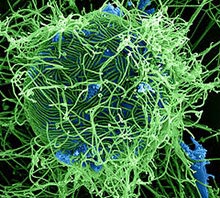
Ebola is the focus of many NIH-supported research efforts, from analyzing the genetics of virus samples to evaluating the safety and effectiveness of treatments and vaccines. Researchers involved in our Models of Infectious Disease Agent Study, or MIDAS, have been using computational methods to forecast the potential course of the outbreak and the impact of various intervention strategies.
Wondering how their work is going, I recently asked our modeling expert Irene Eckstrand a few questions.
How useful are the forecasts?
Forecasts give us a range of possible outcomes. In addition to being a useful public health tool to prepare for an outbreak, they’re an important research tool to test assumptions about how a disease may spread. When we compare the predicted and actual outcomes, we can confirm assumptions, such as the groups of individuals who are more likely to spread the infection to others. Continually doing this helps refine the models and ensure that their forecasts are as accurate as possible.
What are some of the challenges the modelers face?

We need data to build and test models. The data available from this outbreak have been more limited than in most previous outbreaks of Ebola simply because the public health systems are overwhelmed with sick people, and recording information is a secondary priority.
Another issue with forecasting future trends is incorporating information about the deployment of resources and the implementation of interventions that actually slowed the outbreak. We also need to incorporate changes in people’s behavior. If people think an outbreak is leveling off, they may relax the precautions they’ve been taking—and that could lead to another spike in the disease.
What other Ebola-related projects are the MIDAS modelers working on?
The MIDAS researchers are:
- Modeling logistical factors such as the number and placement of treatment beds and staffing needs.
- Tracking potential transmission within and between communities and at hospitals and funerals.
- Developing a method to estimate the amount of underreporting of case data.
- Applying models of “tipping points” to look for evidence that the disease curve is slowing.
- Estimating the number of people who are infected but not symptomatic.
- Creating new resources for Ebola modelers, including standards for using infectious disease data.
- Calculating the risk of importation of cases for a wide variety of countries based on travel networks.
How are the modelers working together?
The MIDAS modelers conference call 1-2 times a week to discuss results, modeling strategies, data sources and questions amenable to modeling. They also participate in discussions with government and other academic groups, so there’s a sizable number of modelers working on a wide variety of public health, logistical and basic research questions.
If you’re interested in learning more about Ebola, Irene recommends a video overview of the 2014 outbreak from Penn State University ![]() and a slide presentation on the myths and realities of the disease from Nigeria’s Kaduna State University
and a slide presentation on the myths and realities of the disease from Nigeria’s Kaduna State University ![]() .
.

